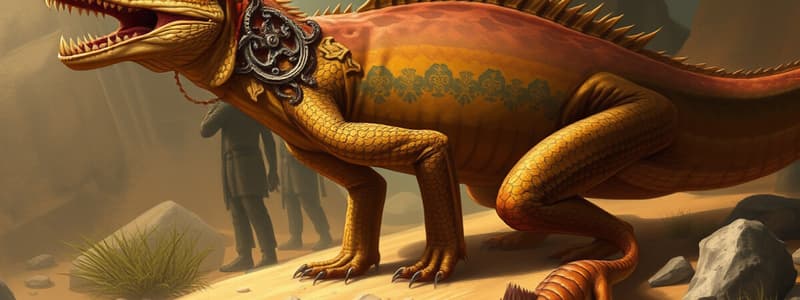Podcast
Questions and Answers
What does the Latin term 'repto' translate to?
What does the Latin term 'repto' translate to?
- To creep (correct)
- To fly
- To swim
- To run
In which geological period did reptiles originate?
In which geological period did reptiles originate?
Late Carboniferous period
During which ages did the Age of Reptiles occur?
During which ages did the Age of Reptiles occur?
Jurassic - Cretaceous
Which of the following changes are associated with life on land?
Which of the following changes are associated with life on land?
What is an amniotic egg?
What is an amniotic egg?
What type of egg is characterized by the prevention of desiccation and gas exchange for embryos?
What type of egg is characterized by the prevention of desiccation and gas exchange for embryos?
Which reproductive strategy involves no aquatic larval stages and miniature adults being born?
Which reproductive strategy involves no aquatic larval stages and miniature adults being born?
What characterizes oviparity in reptiles?
What characterizes oviparity in reptiles?
What is one advantage of ovoviviparity?
What is one advantage of ovoviviparity?
All reptiles use internal fertilization.
All reptiles use internal fertilization.
What significant feature do reptiles have that aids in crushing or gripping prey?
What significant feature do reptiles have that aids in crushing or gripping prey?
What is the primary role of kinetic skulls in reptiles?
What is the primary role of kinetic skulls in reptiles?
Which of the following adaptations are found in the skin of reptiles?
Which of the following adaptations are found in the skin of reptiles?
What type of skeleton adapts reptiles for terrestrial life?
What type of skeleton adapts reptiles for terrestrial life?
What feature allows reptiles to conserve water effectively?
What feature allows reptiles to conserve water effectively?
What is poikilothermy?
What is poikilothermy?
Which order of reptiles is known for having a rigid carapace?
Which order of reptiles is known for having a rigid carapace?
Which reptiles are classified as diapsids?
Which reptiles are classified as diapsids?
Flashcards are hidden until you start studying
Study Notes
General Characteristics of Reptiles
- Derives from the Latin word "repto," meaning to creep.
- Comprises about 7,000 living species, known for their diversity and adaptability to various habitats.
Origins of Reptiles
- Emerged in the Late Carboniferous period (around 300 million years ago) alongside a boom in insect orders due to increased vegetation.
- Became predominant terrestrial vertebrates, utilizing insects as a food source.
Age of Reptiles
- The Jurassic to Cretaceous period marked over 165 million years of reptilian dominance on land.
- Experienced significant evolutionary changes but faced a mass extinction about 65 million years ago at the K-T boundary.
Adaptations for Terrestrial Life
- Developed lungs and internal nostrils for air breathing.
- Adaptations included impermeable skin, strengthened skeletons, and limbs replacing fins.
Reproductive Strategies
- Reproduce without aquatic larval stages, giving birth to miniature adults.
- The amniotic egg is crucial for reproduction independent of water, allowing survival in dry conditions.
Amniotic and Cleidoic Eggs
- The shelled amniotic egg supports embryonic development on land and is essential for the survival of the embryo, preventing desiccation and facilitating gas exchange.
- The cleidoic egg meets essential needs of the embryo, including waste disposal.
Forms of Oviparity
- Majority of reptiles and all birds exhibit oviparity, laying eggs in nests, allowing for maternal care and gas exchange.
- In reptiles, egg shells are generally soft and flexible.
Ovoviviparity and Viviparity
- Some lizards and snakes exhibit ovoviviparity, retaining eggs in the body but providing no nutritional support from the mother.
- Viviparity involves direct nutrient supply for developing young, sometimes forming a placenta.
Skull Structure and Feeding
- Reptilian jaws are adapted for crushing or gripping prey with larger muscles for mechanical advantage.
- Kinetic skulls allow for increased jaw dynamics, found in some birds as well.
Skin and Scales
- Reptiles possess tough, dry, scaly skin, primarily keratinized scales for protection against desiccation.
- Scales vary among species; crocodiles' scales grow continuously, while lizards and snakes shed periodically.
Circulatory and Respiratory Adaptations
- Equipped with a three-chambered heart, most reptiles have higher blood pressure relative to amphibians.
- Respiratory systems include adaptations like rib movements and throat pumping due to the rigid thoracic structure.
Water Conservation Mechanisms
- Metanephric kidneys aid in efficient nitrogenous waste management, excreting uric acid which conserves water.
- Salt glands are present in many species to manage salt excretion.
Skeletal and Limb Adaptations
- Reptiles possess strong, ossified skeletons for life on land, with differentiated cervical vertebrae for better mobility.
- Limb structures vary, with adaptations for climbing, running, or swimming.
Nervous System and Behavior
- Reptilian nervous systems are more complex than those of amphibians, with well-developed sensory organs.
- Behavioral thermoregulation occurs through movement and color changes adapting to temperature variations.
Classification of Reptiles
- High-level classification includes morphological features such as skull fenestrae, leading to categories like anapsid, synapsid, euryapsid, and diapsid.
Orders of Reptiles
- Four extant orders exist:
- Order Cotylosauria (earliest reptiles)
- Order Testudines (turtles and tortoises)
- Order Crocodilia (crocodiles and alligators)
- Order Squamata (scaled reptiles, including lizards and snakes)
New Zealand Reptile Fauna
- New Zealand hosts four living orders: Tuatara, Squamates, marine turtles, and crocodiles.
- The Tuatara is a unique survivor from 220 million years ago, exclusively found in New Zealand.
Lizard Diversity and Adaptations
- High species diversity exists in lizards, with unique adaptations such as specialized feet for climbing.
- Communities exhibit structured spatial and temporal relationships, showcasing high local diversity, especially in New Zealand.
Environmental Temperature Regulation
- Reptiles are ectothermic, regulating body temperature through behavioral strategies, seeking shade or sun exposure.
- Some species have the ability to elevate their body temperature through specific behaviors like basking.
Studying That Suits You
Use AI to generate personalized quizzes and flashcards to suit your learning preferences.




